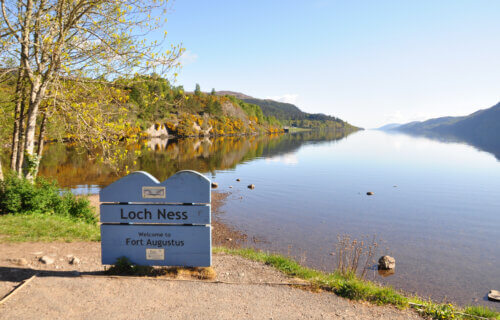Hugh Gray was taking his usual post-church walk around Loch Ness in Scotland on a November Sunday in 1933. His amble was disrupted when he saw something bobbing above the water two or three feet from him. He quickly snapped several pictures of what he described to the Scottish Daily Record as “an object of considerable dimensions”.
A few months earlier, in April 1933, local hoteliers Aldie Mackay and her husband had described a whale-like beast to the Inverness Courier. Then, in the summer of 1933, a man called George Spicer stated: “I saw the nearest approach to a dragon or prehistoric animal that I have ever seen in my life.”
He described a creature between two and three meters long carrying “a lamb or animal of some kind” for its supper.
Since the first sightings, recorded in the latter half of the sixth century, the beast was considered a folk tale. However, when Gray captured the bobbing mass with an animal-like tail it was considered the first photographic proof of “Nessy” and inspired a sort of monster mania.
It’s 90 years since this picture and the beginning of the obsession with finding the Loch Ness monster. As a paleobiologist, I want to explore whether the type of monster we believe Nessie to be could exist and if we should continue looking.

An elaborate hoax?
There are a lot of fish in the loch, so there is enough food. There is also lots of space. Loch Ness is huge, with a volume of 7.4 billion cubic meters and a depth of 227m. There is a lot of water to hide in, which accounts for more than all the fresh water in all of the lakes of England and Wales.
Our idea of what the Loch Ness monster looks like is founded on an iconic picture taken a year after Gray’s. This image showed a long neck stretching from the black waters.
It is the source of the idea that the Loch Ness monster is a living relic from the time of the dinosaurs, eeking out a lonely existence in the depths. However, this image was not what it claimed to be and was found, decades later, to have been an elaborate hoax.
But there is evidence to support the existence of three-metre-long beasties that looked a bit like the Loch Ness monster. These reptiles are known as plesiosaurs and they were wiped out in the mass extinction at the end of the Cretaceous period.
Discoveries of plesiosaur fossils suggest they may have lived in freshwater. The fossils included bones and teeth from three-metre long adults and an arm bone from a 1.5 metre-long baby. However, it’s unlikely that the Loch Ness monster is a plesiosaur.
Unfortunately, the truth comes down to biology. There might be enough food and enough space in the loch but what there is not enough of is other living Loch Ness-like monsters to make a viable population of animals to support Nessy’s existence.
So why look for Nessie or other monsters?
In August this year, Inverness played host to monster hunters scouring the loch with drones equipped with hydrophones and boats pinging sonar, all in the hope of proving the existence of Nessie. They didn’t find anything, which strongly suggests that Loch Ness remains monster-free.
Monster-hunting mania is not reserved to the Loch Ness monster alone. The Mokele-mbembe is another a mythical water-dwelling beast that supposedly lives in the Congo River Basin and looks like a dinosaur. Like Nessie, I doubt it exists.
But I’m not a total party-pooper and I think people should continue their searches for seemingly extinct creatures. Take the thylacine, or Tasmanian wolf, for example. The last Tasmanian wolf was believed to have died in captivity in the 1930s.
However, recent research found that it’s possible the Tasmanian wolf went extinct much later than first thought and maybe hung on until the 2000s. In fact, researchers report that small groups of thylacines may have survived.
And sometimes animals we thought were extinct did come back to the modern world. The coelacanth is perhaps the most famous example.
This fish has a very long fossil record, from the Devonian period through to the end of the Cretaceous period. Then they were gone, thought lost in the same event that destroyed the dinosaurs and plesiosaurs. Not one fossil coelacanth has been described from Paleogene period sediments to today.
But in 1938 a single specimen, caught by fishermen, was found in a South African market by ichthyologist (a marine biologist who studies different fish species) Marjorie Courtney Latimer.
There followed a hunt for the next 20 years to find the population (do read the excellent A Fish Caught in Time) and we now know of two Latimeriid coelacanths in populations around Indonesia and southern Africa.
The take-home message of this is: don’t let anything put you off looking for excitement, or even monsters. You might just find something amazing.

Article written by Neil J. Gostling, Associate Professor in Evolution and Palaeobiology, University of Southampton
This article is republished from The Conversation under a Creative Commons license. Read the original article.
